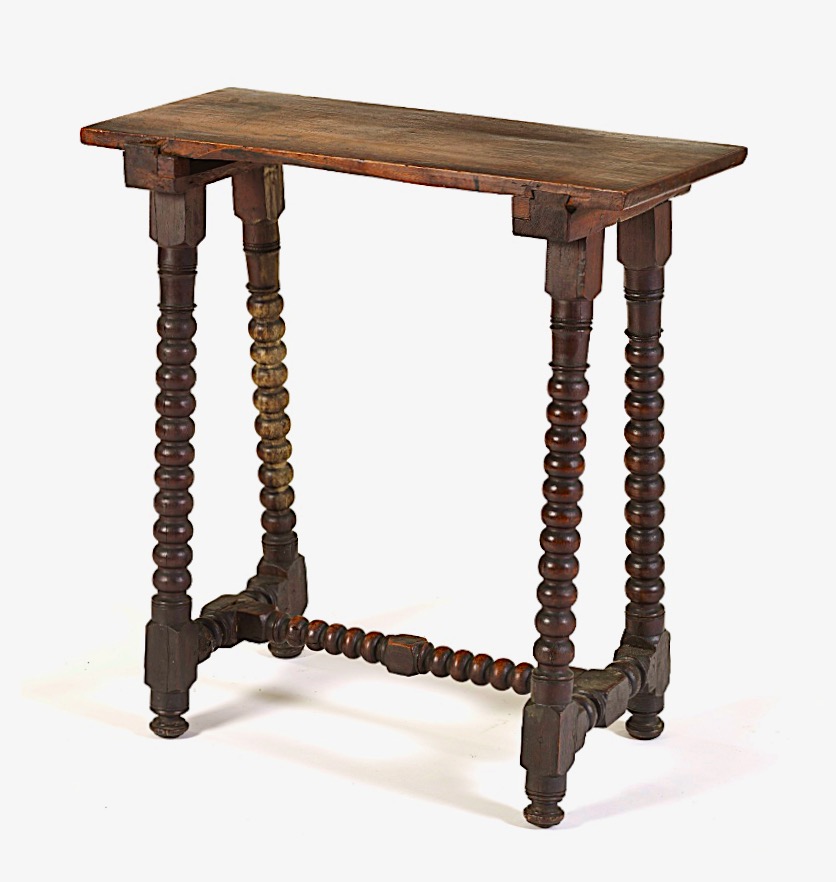

Title: Italian Decorative 19th century Walnut Side Table With Turned Legs
Shipping: $29.00
Artist: N/A
Period: 19th Century
History: Art
Origin: Southern Europe > Italy
Condition: N/A
Item Date: N/A
Item ID: 512
A spectacular rare discovery decorative display side table. This is a Walnut Side Table, an Early 19th Century 28.5" X 26.75" X 13" Italian-style walnut trestle table with turned legs and a stretcher. Provenance: Daniel M. Fawcett Estate private collection, Pittsburgh, PA. Condition: Losses to top, general wear consistent with age, some splits to the legs and stretchers.
The history of the table is intertwined with the evolution of furniture as a whole. Tables have been used by humans for thousands of years and have served various purposes throughout history. Let's explore the history of the table within the category of furniture. Ancient Tables: The earliest known tables date back to ancient Egypt and Mesopotamia, around 3000 BCE. These tables were simple and practical, often consisting of a single slab of stone or wood placed on legs. They were primarily used for dining and were usually low to the ground. Ancient Egyptians also used portable folding tables made of wood. Greek and Roman Tables: In ancient Greece, tables became more sophisticated and decorative. Greek tables were often made of bronze, marble, or wood and featured intricate carvings and designs. The Romans adopted the Greek style but added their own innovations, such as the use of folding tables and smaller side tables known as "tripods." Medieval and Renaissance Tables: During the Middle Ages, tables were primarily functional and practical, reflecting the simpler lifestyle of the time. Trestle tables with removable legs became popular, as they could be easily assembled and disassembled. In the Renaissance period, tables became more ornate and elaborate, with intricately carved legs and decorative inlays. They were often made of expensive materials like oak, walnut, and ebony. 17th to 19th Century Tables: In the 17th century, tables continued to evolve with the emergence of new styles and designs. The Jacobean and William and Mary styles featured heavy, rectangular tables with bulbous legs and stretchers. As the 18th century approached, tables became lighter and more elegant, with the introduction of Rococo and Neoclassical styles. These tables had curvilinear shapes, delicate legs, and were often adorned with intricate marquetry. Industrial Revolution and Modern Tables: The Industrial Revolution in the 19th century brought significant changes to table production. The invention of new machinery and techniques allowed for mass production, making tables more affordable and accessible. Different styles emerged, including the Victorian style with its heavy and ornate tables, and the Arts and Crafts movement, which emphasized simplicity and craftsmanship. 20th Century and Contemporary Tables: In the 20th century, modernist movements such as Art Nouveau, Art Deco, and the Bauhaus influenced table design. Innovative materials like steel, glass, and plastic were introduced, allowing for new forms and experimentation. Designers like Charles and Ray Eames, Marcel Breuer, and Isamu Noguchi created iconic tables that blended functionality with artistic expression. Contemporary tables continue to reflect a wide range of styles and purposes. From traditional dining tables to coffee tables, console tables, and computer desks, there is an incredible variety of table designs available today. Technology has also been integrated into tables, with features like built-in charging ports, adjustable heights, and touch-sensitive surfaces. In conclusion, the history of the table within the category of furniture is a fascinating journey that spans millennia. From simple and practical designs in ancient times to the diverse and innovative creations of today, tables have evolved alongside human needs and design trends, leaving a rich legacy in the world of furniture.